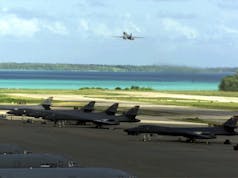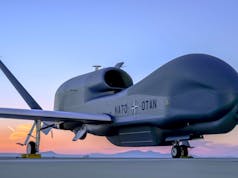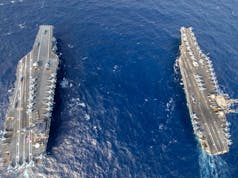The RUSI Land Warfare Conference 2018, held earlier last week, opened my eyes as to the array of problems across defence.
Purpose
The first appears at first glance to be obvious, but it nonetheless is an issue. There doesn’t seem to be a clear consensus as to how the army should evolve. We obviously have plentiful documents and doctrines; the 96 page long 2015 Defence and Security Review is an obvious example. There’s also a 38 page summary ‘fact sheet’, available here, but that is just as long winded. I’ve read both cover-to-cover. There is plenty of procurement information:
• Reaffirming the commitment to ordering 138 Lockheed Martin F-35 Lightning IIs
• 9 Boeing P-8 Poseidon maritime patrol aircraft (first will arrive in 2020, 9 years after Nimrod was scrapped….)
• 589 Ajax armoured vehicles
However, there is no clear consensus as to how defence should evolve existentially. The purpose of defence into the future is not something all agree on. One could write an essay on this, but if I was summarise it in short:
Our military chiefs are clinging to a platform based military. They want their new clever bits of kit. The RAF wants their F-35s, the Royal Navy want their new frigates, and the Army want Ajax, among many other things. They also all want a lot personnel.
Then we have the other group. Those like the National Security Advisor Mark Sedwill who’s obsessed with cyber, software, and AI, and less interested in platform procurement. Or Professor Hugh Durrant-Whyte, who in a nutshell, doesn’t see any need for at all platforms in defence.
Most worryingly, the Modernising Defence Programme (MDP), which will be previewed at the NATO summit in July, doesn’t look like it’ll solve this problem. It’s been written by Mark Sedwill. I got the impression at the Land Warfare Conference that minimal consultation was done with senior army officers, and the majority of the MDP based around budgetary constraints.
There are various existential issues that may be addressed as part of the MDP. As warfare becomes increasingly cyber-centric, all three services try to keep up. They adapt their methods and capabilities to deal with cyber threats. As a result, their cyber capabilities tread closer into GCHQ region.
This is an issue. One of the things discussed at the conference was the different way in which defence procures a capability, compared to civilian companies for example. When the army decides to invest in a technology or programme, by the time they’ve discussed it, trained using it, and declared it operational, it is already several generations out of date in the civilian world. Indeed, a question was asked at the conference whether as warfare becomes increasingly cyber orientated, should our conventional tri-service defence accept that they become less relevant compared to organisations like GCHQ.
I would disagree with that view, but crucially, it is one of many different views of how defence should evolve. The reason people are discussing these views is because currently, there is no consensus. It should be remembered that for the past centuries, armies evolved to get better at eliminating and defending against ‘conventional threats’. In essence, for most of the armies existence, they’ve been tasked with defending against people with weapons, whether those been swords and spears, or rifles.
Now, as our threats become increasingly opaque, the purpose of the army has to adapt. Many people ask the question ‘what will warfare look like in 2068?’. Some conclude with answers that would render capabilities like airborne infantry useless.
The fact of the matter is that whatever warfare will look like in 50 years time, the British Army will endeavour to stay relevant. For them to do so, they need urgently to decide what warfare will look like in the future, develop a plan for how they’re going to evolve to that, and then fund said plan. Right now, there is not consensus on what that plan should look like.
The Royal Navy have essentially been given the ‘thumbs up’ from parliament. They can have two new aircraft carriers because it is believed the aircraft carrier will be a relevant capability in 50 years time. The same goes for the RAF and their F-35 programme. We’ve reached a conclusion that a joint strike fighter will be part of warfare for many decades to come. Both pieces of equipment have been designed such that they can continuously be updated and changed to suit the evolving battlefield.
Urban warfare
Whatever warfare looks like in the future, our adversaries will draw us into cities. In an increasingly urbanised world, urban warfare is hugely difficult. I heard at the conference Captain Ali Smith and WO1 Wendy Eagle, both of whom argued that the British Army are not currently prepared for urban warfare.
The source of this problem appears to be twofold. The first is a lack of training. With the exception of a small number of facilities like Imber Village on Salisbury Plain, the British Army lack environments to train for urban warfare. This is different to French Army for example with their ‘CENZUB’ facility in north-eastern France. The degree of NATO cooperation on this matter appears to be minimal.
The second appears to be psychological. Indeed, the first step to solving a problem is recognising there is one. There were a few blank faces when urban warfare was mentioned at RUSI. The technology simply isn’t there yet to allow us to fight a clean war in built up areas. Theres also the public outcry associated with it, as seen from Amnesty International in response to the retaking of Mosul. It may simply be accepted that urban warafare is a capability the army choose not to develop.
As I stated, the conference was eye opening. It quashed the myth that ‘no state can threaten us’. It also revelaed some real issues with army structure, and capability. Thankfully, General Mark Carleton-Smith was open about these. He recognises issues, and appears willing to endeavour to resolve them.













‘9 years after Nimrod was scrapped’ – with 2 aircraft in service and 1 undergoing engines trials – what a waste.
Yep total waste.
They should have told BAe to ram it from the very start. A better solution would have been an off the shelf existing solution instead of trying to modernise and reuse a small basically 1940/50s designed aircraft to do the job.
It had already been tried with the Nimrod AEW and that was an unmitigated disaster but someone somewhere thought they knew better hence valuable time and money wasted yet again.
BAE always wanted to build new aircraft… it was the MoD who insisted on upgrade rather than new-build.
Nimrod MRA4 was never in service – EVER!
It was – I was talking to some of the engineers who worked on it at the Avro museum 2 years ago who told me this. I don’t think they were lying.
[…] To read more… […]
I believe this issue of crystal ball gazing, probably applies to most defence forces around the World. On paper, the UK’s defence plans look good, with real evidence that new projects are progressing well. The F35 is now on British soil, the Ajax nearly ready to begin volume production and the second QE Class carrier soon to be starting sea trials. And there is more; the first steel and fabrication on the lead Type 26 are underway, and approval for the seventh Astute achieved. Soon the first prototype Challenger 2/B will show itself and there is a good chance that programme will achieve approval (I just hope the numbers of hulls increases?). So, on the evidence set before us, things look better than they have for years.
I would like to see a step up in autonomous/drone planes and tanks especially in the urban environment. Setting troops on the ground in heavily populated locations is risky, and I’d prefer where possible to use remote vehicles. These cannot replace boots on the ground entirely, but it would be better all round if casualties can be reduced markedly.
I hope that the author of this report will not be too disheartened if I was to say that I found his report on the Land Warfare Conference somewhat disappointing. The full title of the conference being ‘Land Warfare conference 21st Century Manoeuvre’. So you guess from that title little time would have been spent discussing equipment being bought for the RAF or the Royal Navy. The major focus being the continuing importance of manoeuvre for the British Army in the future battle space and what shape that manoeuvre will take. There were important contributions from an array of civilian and military experts examining this question not least from the CGS, who all foresaw the importance of Urban warfare. An key statement of intent was made by the CGS that the British Army would become the most ‘competitive’ army in the world. Meaning that in a future war you have to not only win the battle at company and section level you have to win the competition with your adversaries for the narrative, resources, provision of services, law and order and the general civil society.
From that flowed a number of presentations featuring on winning the fight and winning the context of the fight with a particularly interesting contribution from the Army Sergeant Major on why soldiers fight drawn from his own experience.
So I am puzzled who were drawing’ blank faces’ at the mention of urban warfare although with over forty countries attending the conference I suppose some delegates may have been struggling with language issues.
It should be recalled that this conference follows the ‘RUSI Urban Warfare Conference’ held earlier this year that examined in greater detail the Doctrine, Principles, Personnel, Equipment and Training needs of the Army in urban warfare. Indeed 1st armoured Infantry Brigade is the designated ‘experimental brigade’ that is defining the future Doctrinal,Personnel and equipment needs of the British Army that will allow it to manoeuvre successfully in an urban battle.
So we can see that urban warfare is certainly not ‘ a capability the Army choose not to develop’ as the author claims.
I may have been unclear; I speculate as to whether the Army will choose not to develop said capability.
My comments were simply derived from what Captain Ali Smith and WO1 Wendy Eagle said, which was worrying. Certainly two senior British officers shared a worried glance when they started speaking. As was picked up on by Jonathan Beale and a few others, the overall consensus was the training is not quite adequate – this was accepted by CGS in a private breakfast that morning.
I think we are missing a trick or 2 with our defence force.
1. Single integrated “all arms” force structure and a force size around 200k personnel (exc civilians)
2. More offensive capability – many of our assets are poorly specified and/or lack critical mass
3. More assymetrical capability – we should use our natural characteristic for innovation and build lots of smaller lethal platforms that become force multipliers ( apaches, CB90’s etc).
4. Rely on our civilian infrastructure more – we have world class logistics in the UK – use them and concentrate your fighting force on fighting.
7. Invest in our defence industries – they are competitive and high value
8. Have parliament set the budget for defence – not the chancellor (if that can be done for aid – it can be done for defence and law and order).
Haven’t seen any proposals to address the number one issue facing our armed forces.
Recruitment and retention of personnel.
I’ll get flakk for this…
I would eliminate elective cosmetic surgery from the NHS and use the savings to fund priority health care for service personnel. I’m not sure how it works right now, but I do know a friend of mine has had to wait literally years and still hasn’t had his knee fixed, despite this somehow he’s considered deployable.
Please don’t link vanity health projects to gender change. Even if this juxtaposition was accidental it’s not ok.
‘I would eliminate elective cosmetic surgery from the NHS’
Already been done – you can’t get even a skin tag removed on the NHS now. How about the other old one ‘health tourism’ ?
Gastric bands, stop smoking aids etc etc all should be considered. Not going to provide an exhaustive list though you got what I meant.
Except those things help eliminate later problems, lower health costs in the future and help keep people working and productive. Perhaps people who engage in dangerous sports should also be excluded ?
Please don’t equate vanity health projects to gender change. Even if this juxtaposition was accidental it’s not ok.
‘gender changes etc at public expense’ – do you think this is a vanity project, btw ? I’d say it is a very deep and hard decision for those few people that take it. I don’t know if it is the same now, but it used to be a requirement of those wanting it to live as the opposite sex for 2 years before any surgery was done.
Please don’t link gender change to vanity health projects. Even if this juxtaposition is accidental this is not ok.
If we look at the threats and were prepared to cut our cloth according to a realistic budget settlement of between 2.1 and 2.5 of GDP…what capabilities would you invest and disinvest to address aggressive revisionist states.
A credible deterrent, not necessarily ICBM…could be nuclear cruise and economically crippling cyber attack. With enough air superiority fighters for UK defence only.
Specialise in a maritime posture. Carrier strike in terms of theatre access, versatility, power and agility. With generous asw and ssn. Combined with rapidly deployable light forces that can draw down allied heavy fire on advancing forces or stabilise failing states.
Strategic enablers for allies in the direct firing line, such as AWACS, istar, tanking, long range transport, helicopter lift, satellite, command and control, air defence suppression, SF and cigint.
Transfer responsibility to allies to focus on maintenance of large ground forces to defend their own territory. So no tanks, heavy artillery with their heavy logistic tails. Transfer small but niche capability like MCM to small countries that can specialise in an alliance capability.
If you have no tanks you have no theater access. In addition any homeland defense would be crippled without armor support.
In addition heavy artillery is by far more cost effective at dealing with enemy infantry than constant use of aircraft. As provided a fire base is in range you can place a guided 155 shell on a grid square much faster than a jet can bomb it.
Hi Elliot. I’m thinking Falklands and Al paw and Sierra Leone didn’t involve as90, more or chally. I’m also thinking giving up the capability to do armoured division ala desert storm in favour of more capability elsewhere. In particular rapid reinforcement in Baltic’s and Norway, using local their heavy artillery in situ.
Al faw
mlrs
Typos sorry
Possibly.
I was less referring to the AS90 as it is a self-propelled unit. What needs to be done is for the L118s to be supplemented by an order of M777 guns as they are longer ranged and fire a heavier more capable shell. All while still being transportable by a helicopter unlike the AS90 or MLRS both of which require heavy transport by sea or fixed wing aircraft.
The issue with increasing reliance on coalition forces for artillery fire and air support is it increases the time on target as it has the request has to be passed along to the friendly unit in question. While also increasing the chances of friendly fire due to miscommunication.
L118 needs gone. M777 is the way we should have gone years ago
All well and good talking about the short falls in the armed forces and how difficult it is to keep up with technology if you don’t have boots on the ground, ships with crew and aircraft with crew you can’t do anything. I’ve never seen a laptop on the range engageing targets at 300, mobile phone fixing damage kit or computer monitor sitting in a fighter jet patrolin are skies. How many FieldMarshall, Generals, Brigades and on will be sitting in a fire trench with a rifle the day the balloon goes up (not that many). Get the manning problem right for a start. Stop trying to compare the British armed forces to any other armed forces in the world we do what we have to with the best kit in the world or with a bread knife lasses to a broom handle, once again it the person within are armed forces that make it the best you can have not are sing and dancing kit with no one to use it. Del R 2 RGJ S&B
Del, you know as well as I do that they will never cull the boys club on the top corridor. they are stealing a wage and are bloody good at it. unless someone external came in and shook the whole organisation up, it ain’t happening.
A good 80% of the army will have sat on it’s arse this week doing sweet fuck all for various reasons. Apathy to do a RASP/EASP and Lack of will to improve lethality from the middle men in BHQ is a huge problem
Hell, 60% of my working day was on the PS4 because nobody could be arsed to deliver lessons to the junior ranks (not that they needed it because they were the most experienced). The whole thing needs a radical overhaul
I think you are right, we could build 7 more astutes and fit them out with supersonic cruise missiles (that we would need to develop).
The downside is that our subs would not be able to launch convential TLAMs in future as there is no way that an enemy would know if it was nuclear or not.
But I do think this is the way to go
Doesn’t stop the yanks.?
Doesn’t stop the yanks using cruise. Or us dropping dropping bombs given NATO stockpiles of nuclear bombs.
Anthony I am with you all the way but mine countermeasures are a key capability for an island trading nation and it’s removal would be a huge mistake. We are recognised as world leaders in the field for this very reason.
Pacman27 has got the right ideas, only trouble is doing it. Not one of our lot, officers,politions or honourable members of any club will upset the status que.
TH June 28, 2018 at 16:38
Well said. No more vanity health projects, gender changes etc at public expense.
Please don’t equate gender change with vanity health projects. Even if this juxtaposition was accidental, it’s not ok.
Why? In many cases it’s nothing more than your feelings guiding it. What’s the difference between a man who wants to pretend he’s a woman and a woman who wants to pretend she’s a woman with bigger boobs?
Both are peddling a lie. Don’t expect people to cater to your fantasies.
Why? In many cases it’s nothing more than your feelings guiding it. What’s the difference between a man who wants to pretend he’s a woman and a woman who wants to pretend she’s a woman with bigger boobs?
Both are peddling a lie. Don’t expect people to cater to your fantasies.